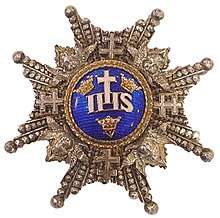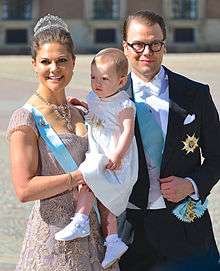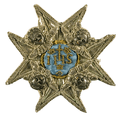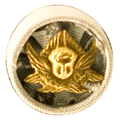Royal Order of the Seraphim
The Royal Order of the Seraphim (Swedish: Kungliga Serafimerorden; Seraphim being a category of angels) is a Swedish order of chivalry created by King Frederick I on 23 February 1748, together with the Order of the Sword and the Order of the Polar Star. The order has only one class with the dignity of Knight (Member for women and Member of the Cloth for clergymen), and is the foremost order of Sweden.
| The Royal Order of the Seraphim Kungliga Serafimerorden | |
|---|---|
 Star of the order | |
| Awarded by Monarch of Sweden | |
| Type | Single grade order of merit |
| Motto | Iesus Hominum Salvator (IHS) |
| Eligibility |
|
| Awarded for | services to Sweden |
| Status | Currently constituted |
| Sovereign | King Carl XVI Gustaf |
| Chancellor | Ingemar Eliasson[1] |
| Grades | Knight/Member (of the Cloth) (general: RSerafO/LSerafO, Swedes: RoKavKMO/LoKavKMO) |
| Statistics | |
| First induction | 1748, Frederick I of Sweden |
| Last induction | 14 June 2019, Moon Jae-in |
| Total inductees | 882 |
| Precedence | |
| Next (higher) | None (highest) |
| Next (lower) | Royal Order of the Sword |
Ribbon bar of the Royal Order of the Seraphim | |
The three above-mentioned Orders together with the Order of Vasa form the Orders of His Majesty the King[2] (Swedish Kungl. Maj:ts Orden).[3] A Swedish Knight of the Order of the Seraphim is not referred to as a Knight of the Seraphim, but rather as a Knight and Commander of the Orders of His Majesty the King (Swedish: Riddare och Kommendör av Kunglig Majestäts Orden). This form is used because the Swedish word orden is an old plural form which indicates that a knight has to be a Commander Grand Cross or Commander of at least one of the other Swedish Orders. Foreign Knights are for the greater part Knights of the Order of the Seraphim. A Knight of the Order may be styled "Herr" + surname, which used to be the formal style for Swedish secular Knights (untitled high-ranking noblemen) appointed by the Swedish King, a practice that ceased in the 17th Century.
When originally instituted the knights of the Order were required to supervise the major hospitals and mental asylums in Sweden, and in particular, the Seraphim Hospital, which was a major hospital in Stockholm until it was closed in 1980. This requirement would die out as boards of physicians and other professionals made such supervision by the Knights of the Seraphim anachronistic during the course of the 19th century.
As part of the reorganization of Swedish orders in 1975, appointments of Swedish citizens to the various orders ceased and conferrals were restricted to foreigners (the last non-royal Swedish holder was Sten Rudholm). Likewise, the Order of the Seraphim was restricted to foreign heads of state and equivalents. In 1995, the law was revised and conferrals upon members of the royal family was allowed.
History
The medieval custom of new crowned monarchs dubbing knights at their coronations[4] as a way of specially honoring particular noblemen was apparently accompanied in Sweden with the gift of a chain apparently specially designed for the occasion. These chains did not indicate the initiation into an order of chivalry as this is usually understood, since the bestowal of a chain of a particular design only occurred at a particular coronation and was not repeated at any other coronations or royal event. The description of some of these chains from the some of pre-Vasa coronations states that they consisted of alternating link of seraphim heads and patriarchal crosses, thus perhaps creating the later impression that there had been an earlier order of the Seraphim of which the 1748 order was seen as a revival. It seems reasonable to assume, at very least, that the accounts of these earlier knightly collars influenced the choice of design for the collar of the 1748 order.
This medieval custom survived into the period of the Vasa dynasty as well, for Eric XIV is known to have bestowed the Order of the Saviour at his coronation in 1561. Similarly, John III had bestowed the Order of the Lamb of God (Agnus Dei) in 1569. It is noteworthy that a contemporary representation of this order shows a collar of alternating red-enameled seraphim heads and gold patriarchal crosses from which hangs as pendant an oval badge enameled blue and bearing the Greek letters of the Christogram IHS (the initials of the name of Jesus in Greek) with a cross above and the three nails of the Passion below between the three crowns of the Swedish royal arms—the same as the central medallion of the latter Order of the Seraphim.[5] Charles IX bestowed the Royal Order of Jehova or Jehova Order at his coronation in 1606—perhaps as Calvinist alternative or reaction to the Catholic devotion to the Name of Jesus implied in his brother's coronation order. Charles X Gustav's Order of the Name of Jesus took the form of a similar circular medallion bearing the letters IHS in diamonds surrounded by a border of diamonds in the center of a cross formed of four enameled Vasa sheaves and hanging from a pink ribbon worn around the neck, of which one example survives in the collections of the Royal Armory.[6] Queen Christina founded an Order of the Amaranth, although apparently not at her coronation, but it also did not survive her reign. Because of these previous orders the first set of statutes described the Order as "revived".
The French Order of the Holy Spirit may have inspired the idea of placing the earlier medallion of the Name of Jesus in the center of a white enameled Maltese cross with gold Seraphim heads between the arms of this cross guarding this medallion with their wings, just as the French order bore the white dove of the Holy Spirit surrounded by green flames on similar white Maltese cross. Also like the French royal orders of chivalry the breast stars of the Swedish orders similarly took the form of silver crosses.
Associated with the Order was the Seraphim Medal awarded to people who made significant contributions to Swedish charities, especially to the hospitals and mental asylums patronized by the Order. This medal consisted a gold coin-like representation of the bust of the Order's founder, King Frederick I, beneath a royal crown hanging by eight small chains from a suspension bar ornamented with a design of acanthus leaves.
Royal family
Until 1975 the sons of the Swedish monarch received a miniature version of the order's insignia at their baptism.[7] As part of a reform on orders and decorations, a law was passed in 1974 restricting the conferral of orders to foreign citizens.[8] This law was revised in 1995 to allow members of the Swedish Royal Family to receive the order.[9][8] That year, on her 18th birthday, Crown Princess Victoria became a member of the order. Prince Carl Philip and Princess Madeline likewise became a knight/member of the order on their 18th birthday. The tradition of conferring the order upon the baptism of a member of the royal family returned when Princess Estelle, the first-born of Crown Princess Victoria and Prince Daniel, received a miniature Grand Cross of the Order's insignia from her grandfather, King Carl Gustaf at her baptism on 22 May 2012. Princess Leonore, daughter of Princess Madeleine and Christopher O'Neill, was also conferred the order at her baptism on 8 June 2014.[10]
Insignia and habits


Knights and Members of the Order wear the badge on a collar (chain) or on a sash from the right shoulder, and the star on the left chest:
- The collar of the Order is in gold, with eleven patriarchal crosses enamelled in turquoise blue and eleven gold seraphim, each represented as a child's head surrounded by six wings, each with a slightly different facial expression.[11]
- The badge of the Order is a white-enamelled gold Maltese Cross, with a gold patriarchal cross on each arm of the cross, and gold seraphim between the arms of the cross and framing with their wings the central medallion. The obverse central medallion is in blue enamel, with a white-enamelled "IHS" Christogram between three gold crowns, beneath which are represented the three nails with which Jesus Christ was crucified. The reverse central medallion is also in blue enamel, with the white-enamelled letters "FRS" (Fredericus, Rex Sueciae, Frederick King of Sweden), the founder of the Order. The badge hangs from a gold and enamelled royal crown. The infant-sized badge is slightly smaller than the regular one.
- The star of the Order is the same as the obverse of the badge without the royal crown, except that the star is entirely of silver[12] and only the central medallion is enamelled as on the badge but larger.
- The ribbon (sash) of the Order is pale blue, referred to in Sweden as seraphim blue. The infant-sized sash is significantly smaller than the regular one.
Habits of the Order
Formerly Knights of the Order also had two distinctive habits, worn on special and formal occasions such as coronations, chapters, etc. They were called the Great Habit and the Lesser Habit.
- The Great Habit was in black and white. The habit included white satin breeches and doublet, with black buttons and trimmed in black lace, over which was worn a black satin mantle, lined with white satin and also trimmed in black lace and a white collar. Both the doublet and the mantle bore the star of the Order embroidered over the left breast and the habit included a pair of white boots with black toes and heels and trimmed in black lace and gilded spurs and a black top hat with a white satin hat band and a plume of white ostrich and black egret feathers.
- The Lesser Habit was in amaranth purple and pale gold. This habit had amaranth velvet breeches and doublet with padded shoulders and pale gold buttons, piping and cuffs and a pale gold satin tasseled sash around the waist, over which was worn an amaranth purple satin mantle lined with pale gold satin and with a pale gold collar. The star of the Order was also embroidered over the left breast on both the mantle and the waistcoat. The habit had black boots and gilded spurs and was worn with the same black top hat with a plume of white ostrich and black egret feathers as the Great Habit, but a pale gold satin hat band.
- The collar of the Order was worn over the doublets of both habits.
 Greater Habit of Prince Fredrik Adolf
Greater Habit of Prince Fredrik Adolf Lesser Habit of King Gustav III
Lesser Habit of King Gustav III
Former investiture ceremony
The nomination of new members took place once a year in the Seraphim Chamber of the Stockholm Palace, usually on the Monday after the first Sunday of Advent, to remind the Knights that faith was due to the King of Zion.
The actual reception into the Order, however, was fixed at 28 April, the birthday of King Frederick I, the founder of the Order. In the interval between the nomination and the reception, the newly elected member could only wear the star, but not the cross with the ribbon.
The reception of new knights into the Order took place at Stockholm in the Riddarholmen Church or in the royal chapel in the Stockholm Palace, in the presence of all the Knights and functionaries of the Order, as also of the Commanders of all the other orders.
The ceremonies were as follows:
The king was seated under a canopy to the right of the altar and the Knights assembled occupied benches to the right and the left, while the newly elected Knight was placed before the altar between two senior Knights, who acted, as it were, as sponsors. After the hymn, "Come, Holy Spirit", was chanted, the chief preacher of the Court briefly addressed those assembled on the duties of the subjects towards God, the King and the country. The Chancellor, who stood to the left of the sovereign, then explained in a few words the object of the order, the honour attached to it, and the reasons which had induced His Majesty to elect the new Knight. The two sponsors, thereupon, conduct the postulant before the King, where he kneels down, and replies affirmatively, with a simple "Yes," to all the following questions:
Did he promise before God and the King:
- To honour, defend and preserve the laws and statutes of the Order?
- To be ready to shed his blood for the Evangelical Lutheran religion and for the welfare of the country?
- To assist, by his courage, to sustain the ancient glory of the Swedish Name?
- To contribute, to the best of his power, to a life of peace and union amongst the Knights of the Order?
- To watch over the honours and privileges now granted to him?
- To do good to the poor and to protect widows and orphans?
On these questions being answered, the King handed the diploma to the Secretary from whom the Chancellor received the document and read it aloud to the assembly, after which the new Knight swore to defend with his life and property the Christian faith, to remain true to the King and the State, to protect the poor, widows and orphans, and to promote their welfare to the best of his power. The King then took from the Treasurer the chain of the Order, hung it round the neck of the new knight and, dubbed him with the coronation sword, saying:
"We, N., King of the Swedes, the Goths and the Wends, receive thee as are brave and honourable Swedish and Gothic Knight of our Order of the Seraphim. Be worthy of it," and embracing him amid the sound of drums and trumpets, he concluded with the words: "May the Lord protect thee!" The new Knight, then thanked His Majesty, kissed his hand, and embraced all his new colleagues, whereupon each of them repeated the words: "May the Lord protect thee!" With this the ceremony concluded.
The practice of dubbing ceased in 1902.
Coats of arms
Each new knight or member has their coat of arms, surrounded with the collar or sash of the order, painted on a copper plate. A selection of these plates is exhibited in Seraphim room at the Royal Palace in Stockholm. When a knight of the Order dies, his coat of arms is hung in the former royal burial church Riddarholmskyrkan in Stockholm, and when the funeral takes place the church bells are rung constantly from 12:00 to 13:00, a practice known as the Serafimerringningen.
Gallery
 Greater Habit worn by Count Carl Axel Trolle Wachtmeister.
Greater Habit worn by Count Carl Axel Trolle Wachtmeister. Lesser Habit worn by Count Carl Axel Trolle Wachtmeister.
Lesser Habit worn by Count Carl Axel Trolle Wachtmeister. King Carl XVI Gustaf with his Collar.
King Carl XVI Gustaf with his Collar. Early model of the star of the order.
Early model of the star of the order. Rosette of the order. Earlier specimen, reintroduced of late.
Rosette of the order. Earlier specimen, reintroduced of late.
See also
- List of Knights of the Royal Order of the Seraphim (the whole historical list)
- List of current Knights of the Royal Order of the Seraphim (currently living ones)
- Orders, decorations, and medals of Sweden
References
- "Hovkalender 2010" (PDF). Riksmarskalkämbetet (Office of the Marshal of the Realm): 17. ISSN 0281-1456. Retrieved 7 July 2010. Cite journal requires
|journal=(help) Alt URL - kungahuset.se
- Orders (in Swedish). Note: This is inconsistent with the English version of the page, which does not include the Order of Vasa in the Orders of HM the King.
- For an English parallel see Order of the Bath in Sir Ivan De la Bere (1964). THE QUEEN'S ORDERS OF CHIVALRY (rev. ed.). London: Spring Books.
- Favine, Andrew (1623). The Theatre of Honour and Knighthood. Translated from the French.
- Conforti, Michael and Guy Walton (eds.). Sweden: A Royal Treasury 1550–1700. Washington, DC: National Gallery of Art, 1988 Exhibition catalogue.
- "Official site". Retrieved 21 October 2014.
- "The Orders in Sweden". kungahuset.se.
- Ordenskungörelse (1974:768)
- "Princess Leonore's Christening". Swedish Royal Court. 8 June 2014. Retrieved 8 June 2014.
- I. e., the front seraph faces the beholder, those immediately on either side are turned slightly towards him; the next three seraphim on either side repeat this patter, while the two remaining seraphim on the back are turned towards each other.
- The current, 2006 model of the Seraphim star has gilded seraphim heads.
- (in Swedish) Per Nordenvall, Kungliga Serafimerorden 1748–1998. Stockholm: Kungl. Maj:ts orden, 1998. ISBN 978-91-630-6744-0
- (in Swedish) Royal Court of Sweden, www.royalcourt.se
- Orders and Decorations of Europe in Color by Paul Hieronymussen and protographed by Aage Struwing; English translation by Christine Crowley. The MacMillan Company. New York, 1967. Originally published as Europaeiske Ordner I Faever @ Politikens Forlag, 1966. Color plates # 18–20; text pp. 124–125.
- The Orders of Chivalry from the Original Statutes of the Various Orders of Knighthood and other Sources of Information by J. H. Lawrence-Archer. London: W. H. Allen and Company, 13 Waterloo Place, Pall Mall, S. W. Publishers to the India Office. 1887.
External links
| Wikimedia Commons has media related to Order of the Seraphim. |
- Swedish Royal Court: Orders
- Orders and Medals
- The Royal Treasury includes some jeweled insignia of the Swedish royal orders of chivalry among the Swedish Crown Jewels, especially those of the Order of the Seraphim. http://www.ordersandmedals.net/Sweden/Seraphim/S207.htm
"www.ordersandmedals.net/Sweden/Seraphim/S209.htm". and http://www.ordersandmedals.net/Sweden/Seraphim/S206.htm.
.svg.png)